page 460



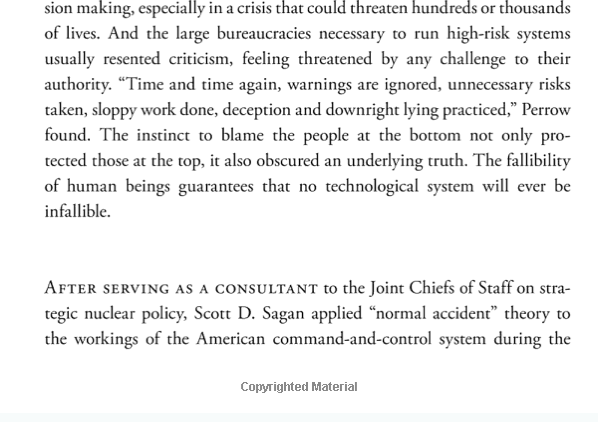
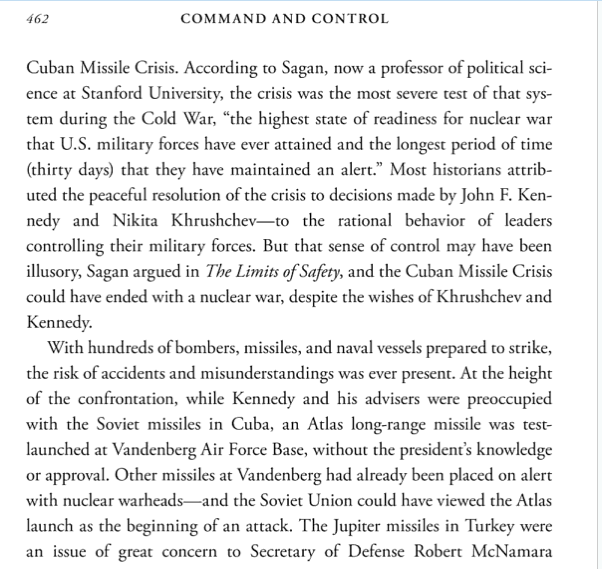

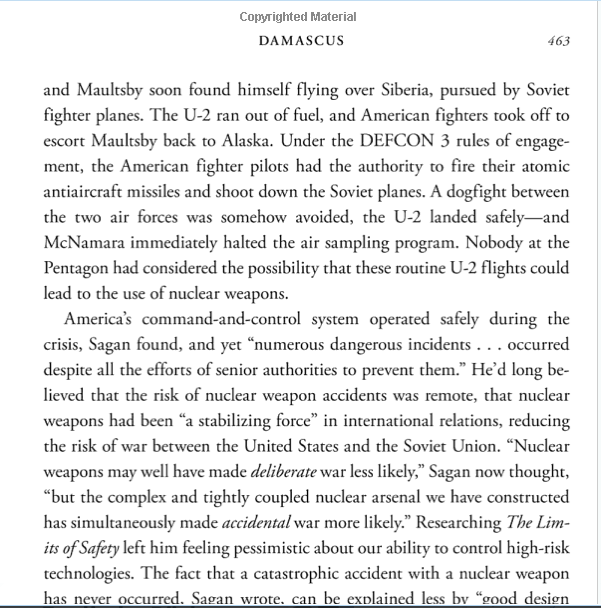

Copyrighted Material
For private use only
2014
page 460








page 464
leak. But to blame the socket, or the person who dropped it, for that explosion is to misunderstand how the Titan II missile system really worked. Oxidizer leaks and other close calls plagued the Titan II until the last one was removed from a silo, northwest of Judsonia, Arkansas, in June 1987. None of those leaks and accidents lead to a nuclear disaster. But if one had, the disaster wouldn't have been inexplicable or hard to comprehend. It would have made perfect sense.
The nuclear weapon system that Bob Peurifoy (in cache), Bill Stevens, and Stan Spray struggled to make safer were tightly coupled, interactive, and complex. They were prone to "common-mode failures" - one problem could swiftly lead to many others. The steady application of high temperature to the surface of a Mark-28 bomb could disable its safety mechanisms, arm it, and then set it off. "Fixes, including safety devices, sometimes create new accidents", Charles Perrow warned, "and quite often merely allow those in charge to run the system faster, or in worse weather, or with bigger explosives". Perrow was not referring to the use of sealed-pit weaponsduring SAC's airborne alerts. But hemight as well have been. Promoted as being much safer then the weapons they replaced, the early sealed-pitbombs posed a grave risk of accidental detonation and plutonium scattering. Normal accident theory isn't a condemnation of modern technological systems. But it calls for more humility in how we design, build, and operate them.
The title of an influential essay on the role of technology in societyasked the question: "Do Artifacts Have Politics?" According to its author, Langdon Winner, the answer is yeas - the things that we produce are not only shaped by social forces, they also help so mold the political life of a society. Some technologies are flexible and can thrive equally well in democratic ir totalitarian countries. But Winner pointed to one envention that could never be managed with completey open, democratic spirit: the atomic bomb. "As long as it exists at all, iths lethal properties demand that it be controlled by a centralized, rigidly hierarchical chain of commend closed to all influences that might make the workings inredictable." Winner wrote: "The internal social system of the bomb must be authoritarian; there is no other way."
page 465
Secrecy is essential to the command and control of nuclear weapons. Their technology is the opposite of open-source-software. The latrest warhead designs can't be freely shared to the internet, improved through anonymous collaboration, and productively used without legal constraints.
In the years since Congress passed the Atomic Energy Act of 1946, the design specifications of American nuclear weapons have been "born secret". They are not classified by government official; they're classified as soon as they exist. An intense secrecy has long surrounded the proposed uses and deployments of nuclear weapons. It is intended to keep valuable information away from America's enemies. But an absence of public scrutiny has often made nuclear weapons more dangerous and more likelt to cause a disaster.
Again and again, safety problems were hidden not only from the public but also from the officersnd enlisted personnel who handled nuclear weapons every day. The strict, compartmentalized secrecy hid safety problems from scientists and engineers responsible for weapon safety. Through the Freedom of Information Act, I obtained a document that listed the "Accidents and Incidents Involving Nuclear Weapons" from the summer of 1957 until the spring of 1967. It was 245 pages long. It gave brief accounts of the major Broken Arrows -in cache- (more - in cache) during that period. It also described hundreds of minor accidents, technical glitches, and seemingly trivial events:
I shared the document with Bob Peurifoy and Bill Stevens - who'd never seen it. Both were upset after reading it. The Defense Atomic Support Agency had never told them about hundreds of accidents.
The United States was often more successful at keeping secrets from its own weapon designers than keeping them from the Soviet Union.Beginning with the Soviet infiltration of the Manhattan Project, through the John Walker spy ring - which fro, the 1960s until 1985 provided
page 466
about a million documents on the Pentagon's war plans, codes, and submarine technology to the Soviets - the leadership in the Kremlin knew a lot more about nuclear capabilities of the United States than the American people were ever allowed to know. One of the most important secrets of the Cold War was considered so secret that the president of the United States wasn't allowed to know it. Harry Truman was deliberately never told that Army cryptologists had broken Soviet codes and deciphered thousands of messages about espionage within the United States. But the Soviet Union learned the secret, when one of its spies, the British double agent Kim Philby, was given a tour of the Army's Signal Intelligence Service headquarters.
The need to protect national security has long been used as a justification for hiding things to avoid embarrassment. "Secrecy is a form of government regulation", a Senate commission, headed by Patrick Moynihan, said in 1997. "What is different with secrecy is that the public cannot know the extent or the content of the regulation." To this day, the classification decisions at the Department of Defense and the Department of Energy have an arbitrary, often Kafkaesque quality. Cold War documents that were declassified in the 1990s were later reclassified - making it illegal to possess them, even though the federal government once released them.
In many of the documents that I obtained through the Freedom of Information Act, ther redactions by government censors made little sense. Exactly the same information would be supplied in one document, yet blacked out in another. The government still won't reveal the yield of the Titan II's warhead - even though the weapon hasn't been in the American aresenal fo almost a quarter of a century, the Soviet Union no longer exists, and Soviet expionage discoverd everything remotely interesting about the missile.
The operational details of nuclear weapons might seem like the kind of information that should always be secret. And yet throughout the Cold War, news reports about Broken Arrow and other nuclear weapon problems forced the Pentagon to adopt new safety measures. Bad publicity influenced the decision
page 467
Too much secrecy often threatened the national security far more than revelations about America's nuclear arsenal.
A detailed account of the nuclear weapon accidents in the Soviet Union has never been published. The absence of a free press no doubt contributed to the many large-scale industrial accidents and widespread environmental devastation that accurred in the Soviet bloc. Chelyabinsk-65, the site of a nuclear weapons facility in central Russia, has been called "arguably the most polluted spot an the planet". A massive explosion there in 1957 contaminated hundreds of square miles with highly radioactive fallout. Countless accidents occurred at the plant, and tens of thousands of people were exposed to harmful levels of radiation. Soviet nuclear technology was, for the most part, inferior to that of the West. But the authoritarian rule of the Soviet Union was especially well suited to the demands of nuclear command and control. Unlike the president of the United States - who predelegated the authority to use nuclear weapons not only to SAC generals and Air Force fighter pilots but also to NATO officers in Europe - the leadership of the Communist Party and the Soviet general staff strictly retained that sort of power. Locks of various kinds were placed on the Soviet weapons, and the permissions to unkock them came only from the top. According to Bruce Blair, a leading command-and-control expert, Soviet safeguards against unauthorized use were "more stringent than those of any other nuclear power, including the United States".
The rightly centralized command structure, however, made the Soviet Union quite vulnerable to a decapitation attack. Despite all the underground bunkers and secret railways built in and around Moscow, Soviet leaders constantly worried about their ability to retaliate after an Anerican first strike. Instead of loosening their control of nuclear weapons and shifting authority further down the chain of command, they automated the decision to use nuclear weapons. In 1974. little more than a decade after the release of Dr. Strangelove, the Soviet Union began work on the "Perimeter" system - a network of sensors and computers that could order the launch
page 268
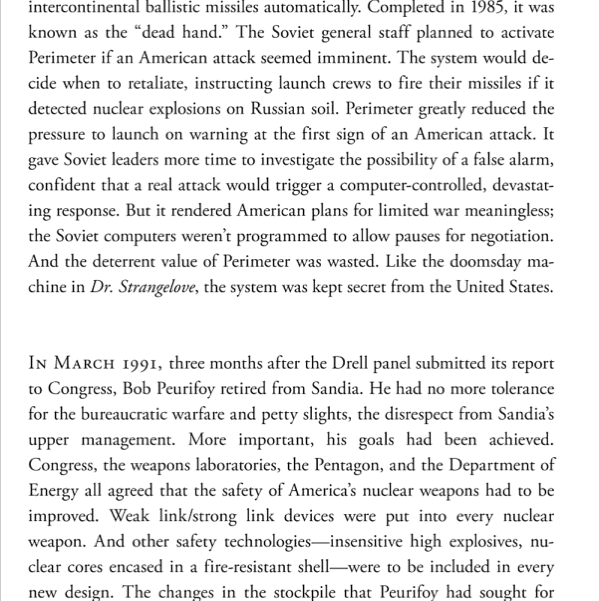
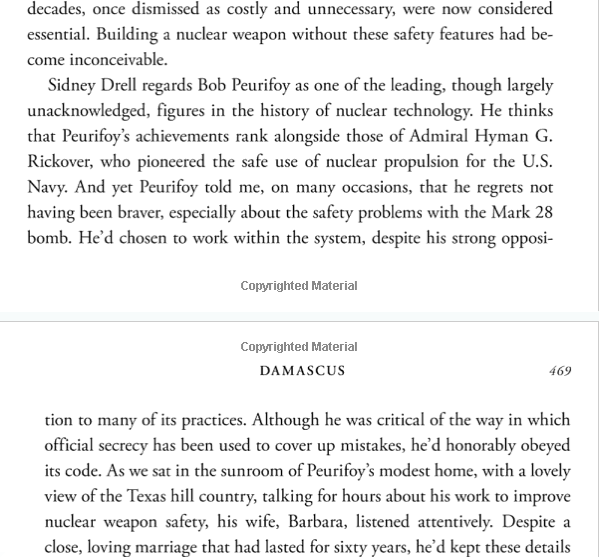
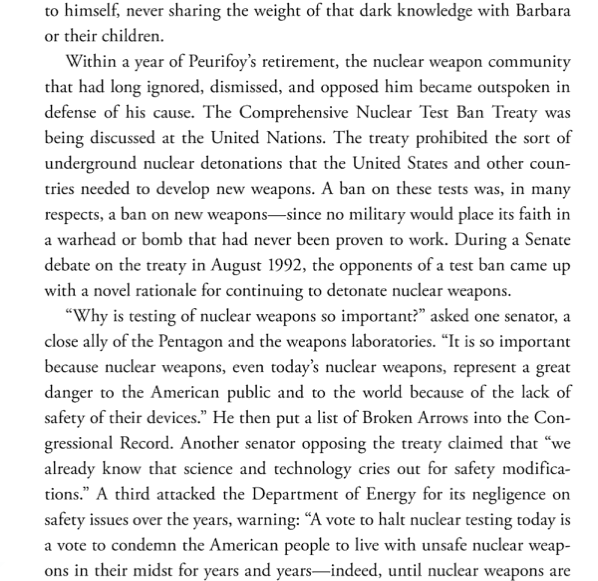
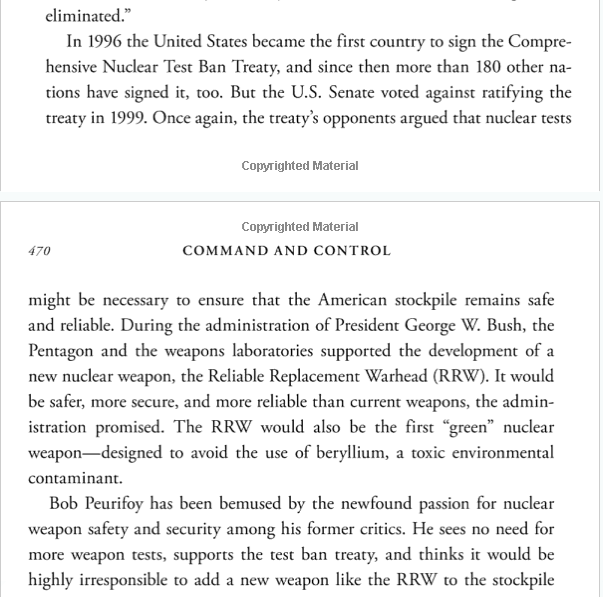

page 471
don't sit on top of the mssile. They surrounded the rocket motor of its third stage, as a space-saving measure. And the navy chose a high-energy propellant for the rocket motor that's much more likeley to explode in an accident - simply by being dropped or struck by a bullet - than other solid fuels. A Trident submarine has as many as 24 of these missiles, each carrying between 4 - 5 warheads. An accident with one missile could detonate the third-stage propellant, set off the high explosives of the wrheads, and spread a good deal of plutonium around the ports in Georgia and Washington State where Trident submarines are based.
For years the navy has resisted changing the third-stage rocket propellant of the Trident II missile or using the W-87 warhead - which is almost identical to the W-88 but employs a safer insensitive high explosive. Using a less energetic propellant would decrease the missile's range by perhaps 4%, and the W-87 warhead has a slightly lower yield. Parochial concerns may also be a factor in the navy's attachment to the W-88. That warhead was designed for the Navy by Los Alamos; the W-87 by Lawrence Livermore for the Air Force.
The best way to load a Trident II missile onto a submarine is one of the few areas of disagreement between Sidney Drell and Bob Peurifoy. Drell endorses the Navy's current method: load the missile first, then attach the warheads. Peurifoy prefers another method: put the fully assembled missiles into the launch tubes. The difference between the two opinions may seem esoteric, and yet the potential consequences of an accident are beyond dispute: a missile explosion inside a submarine with as many as 144 nuclear warheads.
Version: 2 May 2019
Address of this page